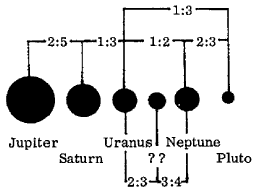 |
Science Frontiers ONLINE No. 51: May-Jun 1987 |
|
|
Were titius and bode right?
For a couple of centuries, astronomers have been trying to explain in physical terms why the empirical and very simple formula of Titius and Bode works so well. It is only an unimposing geometric progression, which, if one inserts the earth's average distance from the sun, yields the distances of the other planets with enough accuracy to perturb astronomers. You see, all scientists abhor numerology. They must insist that the Titius-Bode Law has physical underpinnings.
S. Weldenschilling and D. Davis now propose that the planets owe their present positions to a combination of two effects:
- The frictional drag of the gas in the solar nebula, which favors the presence of small planets in the inner solar system.
- Gravitational perturbations that create favored places for the coalesceing of planets.
C. Patterson has expanded on this suggestion and finds that a model based on these effects works quite well for Jupiter and beyond, where planets are "bound together" in an interlocking system of orbital-period resonances. (See diagram.)
Several important anomalies persist, however. That vacant niche between Uranus and Neptune is presently unexplained. In the inner solar system, the presence of Mercury is "embarrassing." (Anonymous; "Were Titius and Bode Right?" Sky and Telescope, 73:371, 1987.
Reference. The "problem" of Mercury is treated in AHB2 in The Moon and the Planets. This catalog is described here.
 | In C. Patterson's model the outer planets accreted at those spots where their orbital periods formed simple ratios. Planet ? ? is indicated by this theory, but has never been found. |